River Shannon: Difference between revisions
Created page with 'right|thumb|300px|The young River Shannon at Drumsna Bridge, County Leitrim The '''River Shannon''' is the longest river in [[Irela…' |
No edit summary |
||
| (3 intermediate revisions by 3 users not shown) | |||
| Line 1: | Line 1: | ||
[[File:River Shannon from Drumsna bridge.jpg|right|thumb|300px|The young River Shannon at Drumsna Bridge, County Leitrim]] | [[File:River Shannon from Drumsna bridge.jpg|right|thumb|300px|The young River Shannon at Drumsna Bridge, County Leitrim]] | ||
The '''River Shannon''' is the longest river in [[Ireland]] at | The '''River Shannon''' is the longest river in [[Ireland]] at 224 miles.<ref>{{cite web| url=http://www.osi.ie/en/faq/faq3.aspx#faq2 |publisher=Ordnance Survey Ireland |title=Frequently Asked Questions}}</ref> It is the great artery of the island, outside Ulster at least, has been the conduit and subject of a great deal of history and the cultural imagination, dividing [[Counties of the Republic of Ireland|counties]] and [[Provinces of Ireland|provinces]] but uniting them by trade. | ||
The Shannon flows entirely in the [[Republic of Ireland]]. It divides the west of Ireland (principally the [[Provinces of Ireland|province]] of [[Connaught]]) from the east and south ([[Leinster]] and most of [[Munster]]). [[County Clare]] alone stands west of the Shannon but is part of Munster. The river represents a major physical barrier between east and west, as there are fewer than thirty crossing-points between [[Limerick]] in the south and the village of [[Dowra]] in the north. | The Shannon flows entirely in the [[Republic of Ireland]]. It divides the west of Ireland (principally the [[Provinces of Ireland|province]] of [[Connaught]]) from the east and south ([[Leinster]] and most of [[Munster]]). [[County Clare]] alone stands west of the Shannon but is part of Munster. The river represents a major physical barrier between east and west, as there are fewer than thirty crossing-points between [[Limerick]] in the south and the village of [[Dowra]] in the north. | ||
| Line 21: | Line 21: | ||
There are some tributaries within the River Shannon system which may have headwaters that are further in length (from source to mouth) than the Shannon Pot source, such as the [[Owenmore River]] in County Cavan, which flows west through the valley of Glengavlin, joining the Shannon about 2 miles below Lugnashinna.<ref>{{cite book |title=Atlas and Cyclopedia of Ireland |author=P. W. Joyce | chapter=Cavan |url=http://www.libraryireland.com/Atlas/Cavan.php |year=1900 |publisher=Murphy & McCarthy}}</ref> | There are some tributaries within the River Shannon system which may have headwaters that are further in length (from source to mouth) than the Shannon Pot source, such as the [[Owenmore River]] in County Cavan, which flows west through the valley of Glengavlin, joining the Shannon about 2 miles below Lugnashinna.<ref>{{cite book |title=Atlas and Cyclopedia of Ireland |author=P. W. Joyce | chapter=Cavan |url=http://www.libraryireland.com/Atlas/Cavan.php |year=1900 |publisher=Murphy & McCarthy}}</ref> | ||
Apart from being Ireland's longest river, the Shannon is also, by far, Ireland's largest river (by flow). It has a Long Term Average Flow rate of {{convert|208.1|m3| | Apart from being Ireland's longest river, the Shannon is also, by far, Ireland's largest river (by flow). It has a Long Term Average Flow rate of {{convert|208.1|m3|0|x}} a second: this is double the flow rate of Ireland's 2nd largest river, the [[River Corrib]] in [[County Galway]] ({{convert|104.8|m3|0|x}} a second).<ref>http://www.serbd.com/MultiDownloads/Creport/Chapters/Physical%20Description%20Ch3.pdf</ref> | ||
Major lakes on the Shannon include: | Major lakes on the Shannon include: | ||
| Line 47: | Line 47: | ||
[[File:ShannonRiversml.png|right|thumb|250px|Course of River Shannon]] | [[File:ShannonRiversml.png|right|thumb|250px|Course of River Shannon]] | ||
[[File:Shannon at Limerick.jpg|right|thumb|250px|The Shannon at Limerick]] | [[File:Shannon at Limerick.jpg|right|thumb|250px|The Shannon at Limerick]] | ||
Though the Shannon has always been important for navigation in Ireland, there is a fall of only 60 feet in the first 140 miles. Consequently it has always been shallow; just 2 feet in depths in various places. The first serious attempt to improve things came in 1755 when the Commissioners of Inland Navigation ordered Thomas Omer, a new, possibly Dutch immigrant from Britain, to commence work.<ref>{{cite book|author=Ruth Delaney|title=Ireland's Inland Waterways|publisher=Appletree Press|year=2004}}</ref> He tackled four places between [[Lough Derg (Shannon)|Lough Derg]] and [[Lough Ree]] where natural navigation was obstructed, by installing lateral canals and either pound locks or flash locks. He then continued north of Lough Ree and made a number of similar improvements, most notably by creating the first Jamestown Canal which cut out a loop of the river between [[Jamestown, County Leitrim|Jamestown]] and [[Drumsna]] as well lateral canals at [[Roosky]] and [[Lanesborough, County Longford|Lanesborough]]. | Though the Shannon has always been important for navigation in Ireland, there is a fall of only 60 feet in the first 140 miles. Consequently, it has always been shallow; just 2 feet in depths in various places. The first serious attempt to improve things came in 1755 when the Commissioners of Inland Navigation ordered Thomas Omer, a new, possibly Dutch immigrant from Britain, to commence work.<ref>{{cite book|author=Ruth Delaney|title=Ireland's Inland Waterways|publisher=Appletree Press|year=2004}}</ref> He tackled four places between [[Lough Derg (Shannon)|Lough Derg]] and [[Lough Ree]] where natural navigation was obstructed, by installing lateral canals and either pound locks or flash locks. He then continued north of Lough Ree and made a number of similar improvements, most notably by creating the first Jamestown Canal which cut out a loop of the river between [[Jamestown, County Leitrim|Jamestown]] and [[Drumsna]] as well lateral canals at [[Roosky]] and [[Lanesborough, County Longford|Lanesborough]]. | ||
The lower Shannon between [[Killaloe, County Clare|Killaloe]] and [[Limerick]] was a different story. Here the river falls by 100 feet in only {{convert|20|km|mi|0|x}}. William Ockenden was placed in charge of this in 1757 and spent £12,000 over the next four years without fully completing the task. In 1771, Parliament handed over responsibility to the Limerick Navigation Company with a grant of £6,000 to add to their subscriptions of £10,000. A lateral canal five miles long with six locks was started but the company needed more to complete it. In 1791, William Chapman was brought in to advise and discovered a sorry state of affairs. All the locks had been built to different dimensions and he spent the next three years rebuilding most of them. The navigation was finally opened in 1799, when over 1,000 tons of corn came down to Limerick, as well as slates and turf. But even then, there were no tow paths in the river sections and there were still shoals in the summer months, no harbour facilities at Limerick and boats were limited to 15-20 tons load, often less. | The lower Shannon between [[Killaloe, County Clare|Killaloe]] and [[Limerick]] was a different story. Here the river falls by 100 feet in only {{convert|20|km|mi|0|x}}. William Ockenden was placed in charge of this in 1757 and spent £12,000 over the next four years without fully completing the task. In 1771, Parliament handed over responsibility to the Limerick Navigation Company with a grant of £6,000 to add to their subscriptions of £10,000. A lateral canal five miles long with six locks was started but the company needed more to complete it. In 1791, William Chapman was brought in to advise and discovered a sorry state of affairs. All the locks had been built to different dimensions and he spent the next three years rebuilding most of them. The navigation was finally opened in 1799, when over 1,000 tons of corn came down to Limerick, as well as slates and turf. But even then, there were no tow paths in the river sections and there were still shoals in the summer months, no harbour facilities at Limerick and boats were limited to 15-20 tons load, often less. | ||
| Line 92: | Line 92: | ||
[[Category:Rivers of County Offaly]] | [[Category:Rivers of County Offaly]] | ||
[[Category:Rivers of County Roscommon]] | [[Category:Rivers of County Roscommon]] | ||
[[Category:Rivers of Tipperary]] | [[Category:Rivers of County Tipperary]] | ||
[[Category:Rivers of Westmeath]] | [[Category:Rivers of Westmeath]] | ||
Latest revision as of 06:22, 22 May 2018
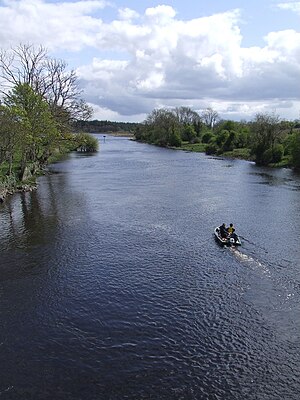
The River Shannon is the longest river in Ireland at 224 miles.[1] It is the great artery of the island, outside Ulster at least, has been the conduit and subject of a great deal of history and the cultural imagination, dividing counties and provinces but uniting them by trade.
The Shannon flows entirely in the Republic of Ireland. It divides the west of Ireland (principally the province of Connaught) from the east and south (Leinster and most of Munster). County Clare alone stands west of the Shannon but is part of Munster. The river represents a major physical barrier between east and west, as there are fewer than thirty crossing-points between Limerick in the south and the village of Dowra in the north.
The Shannon has been an important waterway since antiquity. It was described by the Graeco-Egyptian geographer Ptolemy. The river flows generally southward from the Shannon Pot in County Cavan before turning west and emptying into the Atlantic Ocean through the long Shannon Estuary, 70 miles long. Limerick city stands at head of the estuary, where the river water meets the sea water. The Shannon is unaffected by sea tides east of Limerick.
Name
The Irish language knows the Shannon as an tSionainn or an tSionna, or Abha na Sionainne. It is named, so it is said, after an Irish goddess named Sionna.[2]
Geography
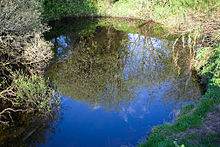
By tradition the Shannon is said to rise in the Shannon Pot, a small pool on the slopes of Cuilcagh Mountain in County Cavan, from where the young river appears as a small trout stream. Surveys have defined a 4.9 square miles immediate pot catchment area covering the slopes of Cuilcagh, which area includes Garvah Lough, Cavan, a mile and a half to the northeast, drained by Pollnaowen.[n 1] Further sinks that source the pot include Pollboy and, through Shannon Cave, Pollahune in Cavan and Polltulyard and Tullyrrakeeragh in Fermanagh, in the United Kingdom. The highest point in the catchment is a spring at Tiltinbane on the western end of the Cuilcagh mountain ridge.[3]
From the Shannon Pot, the river subsumes a number of tributaries before replenishing Lough Allen at its head.[4]

The river runs through or between 11 of Ireland's counties, subsuming the tributary rivers Inny, Suck and Brosna, before reaching the Shannon Estuary at Limerick. At a total length of 224 miles, this means it is the longest river in both Ireland and the wider British Isles.[5][6][7][8][9]
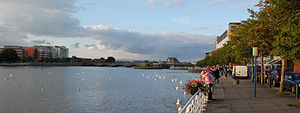
There are some tributaries within the River Shannon system which may have headwaters that are further in length (from source to mouth) than the Shannon Pot source, such as the Owenmore River in County Cavan, which flows west through the valley of Glengavlin, joining the Shannon about 2 miles below Lugnashinna.[10]
Apart from being Ireland's longest river, the Shannon is also, by far, Ireland's largest river (by flow). It has a Long Term Average Flow rate of 45,776 gallons a second: this is double the flow rate of Ireland's 2nd largest river, the River Corrib in County Galway (23,053 gallons a second).[11]
Major lakes on the Shannon include:
History and folklore
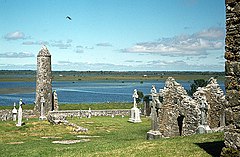
The river began flowing along its present course after the end of the last Ice Age.
According to Irish mythology, the river was named after a woman named Sionann (older spelling: Sínann or Sínand), the granddaughter of Lir. She went to Connla's Well to find wisdom, despite being warned not to approach it. In some sources she, like Fionn mac Cumhaill, caught and ate the Salmon of Wisdom who swam there, becoming the wisest being on Earth. However, the well then burst forth, drowning Sionann and carrying her out to sea.[12] A similar tale is told of Boann and the River Boyne. It is believed that Sionann was held to be the goddess of the river. Patricia Monaghan notes that "The drowning of a goddess in a river is common in Irish mythology and typically represents the dissolving of her divine power into the water, which then gives life to the land".[13]
The Shannon reputedly hosts a river monster named Cata, first appearing in the mediæval Book of Lismore. In this manuscript we are told that Senán, patron saint of County Clare, defeated the monster at Inis Cathaigh.[14] Cata is described as a large monster with a horse's mane, gleaming eyes, thick feet, nails of iron and a whale's tail.[15]
Vikings settled in the region in 10th century and used the river to raid the rich monasteries deep inland. In 937 the Limerick Vikings clashed with those of Dublin on Lough Ree and were defeated.
In the 17th century, the Shannon was of major strategic importance in military campaign in Ireland, as it formed a physical boundary between the east and west of the country. In the Irish Confederate Wars of 1641-53, the Irish retreated behind the Shannon in 1650 and held out for two further years against English Parliamentarian forces. In preparing a land settlement, or plantation after his conquest of Ireland Oliver Cromwell reputedly said the remaining Irish landowners would go to "Hell or Connaught", referring to their choice of forced migration west across the river Shannon, or death, thus freeing up the eastern landholdings for the incoming English settlers.
In the Williamite war in Ireland (1689–91), the Jacobites also retreated behind the Shannon after their defeat at the Battle of the Boyne in 1690. Athlone and Limerick, cities commanding bridges over the river, saw bloody sieges.
As late as 1916, the leaders of the Easter Rising planned to have their forces in the west "hold the line of the Shannon". However, in the event, the rebels were neither well enough armed nor equipped to attempt such an ambitious policy.
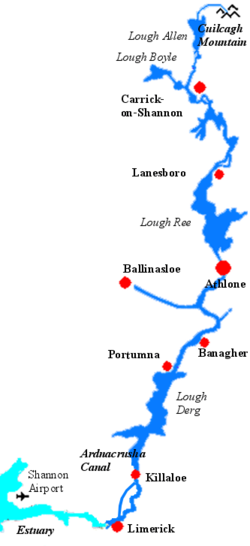
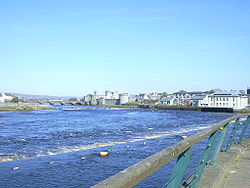
Though the Shannon has always been important for navigation in Ireland, there is a fall of only 60 feet in the first 140 miles. Consequently, it has always been shallow; just 2 feet in depths in various places. The first serious attempt to improve things came in 1755 when the Commissioners of Inland Navigation ordered Thomas Omer, a new, possibly Dutch immigrant from Britain, to commence work.[16] He tackled four places between Lough Derg and Lough Ree where natural navigation was obstructed, by installing lateral canals and either pound locks or flash locks. He then continued north of Lough Ree and made a number of similar improvements, most notably by creating the first Jamestown Canal which cut out a loop of the river between Jamestown and Drumsna as well lateral canals at Roosky and Lanesborough.
The lower Shannon between Killaloe and Limerick was a different story. Here the river falls by 100 feet in only 12 miles. William Ockenden was placed in charge of this in 1757 and spent £12,000 over the next four years without fully completing the task. In 1771, Parliament handed over responsibility to the Limerick Navigation Company with a grant of £6,000 to add to their subscriptions of £10,000. A lateral canal five miles long with six locks was started but the company needed more to complete it. In 1791, William Chapman was brought in to advise and discovered a sorry state of affairs. All the locks had been built to different dimensions and he spent the next three years rebuilding most of them. The navigation was finally opened in 1799, when over 1,000 tons of corn came down to Limerick, as well as slates and turf. But even then, there were no tow paths in the river sections and there were still shoals in the summer months, no harbour facilities at Limerick and boats were limited to 15-20 tons load, often less.
With the approaching opening of the Grand Canal, the Grand Canal Company obtained permission from the Directors General and asked John Brownrigg to do a survey which found that much of Omer's work had deteriorated badly, so they started repairs. After protracted negotiations on costs and conditions, the work was completed by 1810 so that boats drawing 5'9" could pass from Athlone to Killaloe. Improvements on the lower levels were also undertaken, being completed by 1814.
When the Royal Canal was completed in 1817 there was pressure to improve the navigation above Lough Ree. The Jamestown Canal was repaired, harbours built and John Killaly designed a canal alongside the river from Battlebridge to Lough Allen which was opened in 1820.
In the latter part of the 1820s, trade increased dramatically with the arrival of paddle-wheeled steamers on the river which carried passengers and goods. By 1831 14,600 passengers and 36,000 tons of freight were being carried. This put new pressure on the navigation and a commission was set up resulting in the Shannon Navigation Act of 1835 appointing five Commissioners for the improvement of navigation and drainage who took possession of the whole navigation. Over the next 15 years many improvements were made but in 1849 a railway was opened from Dublin to Limerick and the number of passengers fell dramatically. Freight, which had risen to over 100,000 tons a year, was also halved.
But the work the commissioners carried out failed to solve the problems of flooding and there were disastrous floods in the early 1860s. Given the flat nature of most of the riverbank this was not easily addressed and nothing much was done till the twentieth century.
One of the first projects of the Irish Free State in the 1920s was to build the Ardnacrusha power station on the lower Shannon near Killaloe. The old navigations were abandoned and the head race constructed from Lough Derg which also served for navigation. A double lock has been provided for navigation.
In the 1950s traffic began to fall and low fixed bridges would have replaced opening bridges but for the actions of the Inland Waterways Association of Ireland which persuaded the Tánaiste to encourage passenger launches, which kept the bridges high enough for navigation. Since then the leisure trade has steadily increased, becoming a great success story.
Canals
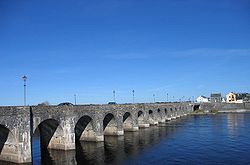
There are many canals connecting with the River Shannon. The Royal Canal and the Grand Canal connect the Shannon to Dublin and the Irish Sea.
It is linked to the River Erne and Lough Erne by the Shannon-Erne Waterway. Ballinasloe is linked to the Shannon by way of the River Suck and canal, while Boyle is connected by the Boyle canal, the River Boyle and Lough Kee. There is also the Ardnacrusha canal connected with the Ardnacrusha dam south of Lough Derg. Near Limerick, a short canal connects Plassey with the Abbey River, allowing boats to bypass the Curraghower Falls, a major obstacle to navigation.
Lecarrow village in County Roscommon is connected to Lough Ree by way of the Lecarrow canal. Jamestown Canal and the Albert Lock form a link between the River Shannon, from south of Jamestown, to Lough Nanoge to the south of Drumsna.
Outside links
| ("Wikimedia Commons" has material about River Shannon) |
- Information, maps etc. on The Shannon Navigation (from Inland Waterways Association of Ireland)
- "River Shannon". Encyclopædia Britannica. http://www.britannica.com/EBchecked/topic/538586/River-Shannon.
References
- ↑ Note Poll nm1: hole, pit, sink, leak, aperture (The Pocket Oxford Irish Dictionary - Irish-English)
- ↑ "Frequently Asked Questions". Ordnance Survey Ireland. http://www.osi.ie/en/faq/faq3.aspx#faq2.
- ↑ Mícheál O Súilleabháin. "Listening to difference: Ireland in a world of music". in Harry Bohan and Gerard Kennedy. Global aspirations and the reality of change. http://www.catholicireland.net/books-a-media/193-moral-issues-a-values/443-global-aspirations-and-the-reality-of-change.
- ↑ Philip Elmer et al. Springs and Bottled Waters of the World Springer ISBN 3-540-61841-4
- ↑ The Shannon Guide
- ↑ "Source of the River Shannon, Ireland". Environmental Geology (Springer) 27 (2): 110–112. Jan 31 2005. doi:10.1007/BF01061681. http://www.springerlink.com/content/t8420623471u73h7/.
- ↑ "Nature & Scenery". Discover Ireland. http://www.discoverireland.com/gb/about-ireland/nature/.
- ↑ Studia Hibernica, No.4 (1964). Available: http://www.jstor.org/pss/20495797 Accessed: 10-August-2011.
- ↑ Accessed: 10-August-2011.
- ↑ Accessed: 10-August-2011.
- ↑ P. W. Joyce (1900). "Cavan". Atlas and Cyclopedia of Ireland. Murphy & McCarthy. http://www.libraryireland.com/Atlas/Cavan.php.
- ↑ http://www.serbd.com/MultiDownloads/Creport/Chapters/Physical%20Description%20Ch3.pdf
- ↑ Monaghan, Patricia. The Encyclopedia of Celtic Mythology and Folklore. Infobase Publishing, 2004. p.420
- ↑ Monaghan, p.27
- ↑ A Folklore Survey of County Clare: Supernatural Animals. Clarelibrary.ie. Retrieved on 2013-07-23.
- ↑ Cata The Monster of Shannon Waves : A true Story by Shane Mac Olon
- ↑ Ruth Delaney (2004). Ireland's Inland Waterways. Appletree Press.
